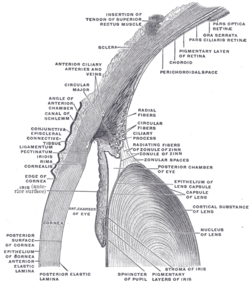Conjunctiva
| Conjunctiva | |
|---|---|

The upper half of a sagittal section through the front of the eyeball. (Label for 'Conjunctiva' visible at center-left.)
|
|

Horizontal section of the eyeball. (Conjunctiva labeled at upper left.)
|
|
| Details | |
| Part of | Eye |
| Artery | lacrimal artery, anterior ciliary arteries |
| Nerve | supratrochlear nerve |
| Identifiers | |
| Latin | tunica conjunctiva |
| MeSH | A09.371.192 |
| TA | A15.2.07.047 |
| FMA | 59011 |
|
Anatomical terminology
[]
|
|
The conjunctiva lines the inside of the eyelids and covers the sclera (the white of the eye). It is composed of non-keratinized, stratified squamous epithelium with goblet cells, and also stratified columnar epithelium. The conjunctiva is highly vascularised, with many microvessels easily accessible for imaging studies.
The conjunctiva is typically divided into three parts:
Blood to the bulbar conjunctiva is primarily derived from the ophthalmic artery. The blood supply to the palperbral conjunctiva (the eyelid) is derived from the external carotid artery. However, the circulation of the bulbar conjunctiva and palpebral conjunctiva are linked, so both bulbar conjunctival and palpebral conjunctival vessels will be supplied by both the ophthalmic artery and the external carotid artery, to varying extents.
Sensory innervation of the conjunctiva is divided into four parts:
The conjunctiva consists of non-keratinized, both stratified squamous and stratified columnar epithelium, with interspersed goblet cells. The epithelial layer contains blood vessels, fibrous tissue, and lymphatic channels. Accessory lacrimal glands in the conjunctiva constantly produce the aqueous portion of tears. Additional cells present in the conjunctival epithelium include melanocytes, T and B cell lymphocytes.
The conjunctiva helps lubricate the eye by producing mucus and tears, although a smaller volume of tears than the lacrimal gland. It also contributes to immune surveillance and helps to prevent the entrance of microbes into the eye.
Disorders of the conjunctiva and cornea are a common source of eye complaints, in particular because the surface of the eye is exposed to various external influences and is especially susceptible to trauma, infections, chemical irritation, allergic reactions and .
...
Wikipedia
